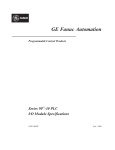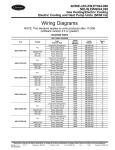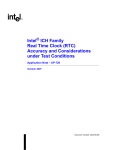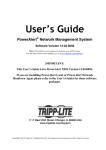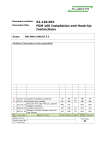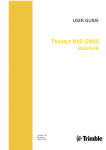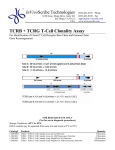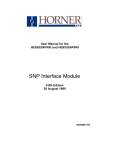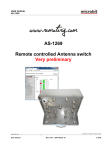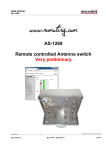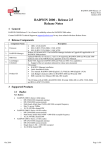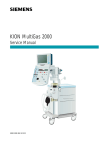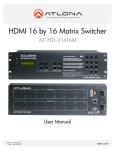Download 12 - Cimtec Automation
Transcript
This Datasheet is for the IC693ALG442 Analog Current/Voltage Combination Module 4 Input/2 Output Channels http://www.cimtecautomation.com/parts/p-14577-ic693alg442.aspx Provides the wiring diagrams and installation guidelines for this GE Series 90-30 module. For further information, please contact Qualitrol Technical Support at 1-800-784-9385 [email protected] Chapter 12 IC693ALG442 Analog Combination I/O section level 1 1 Module figure bi level 1 12 table_big level 1 Analog Current/Voltage Combination Module 4 Input/2 Output Channels - IC693ALG442 The Analog Current/Voltage Combination Input/Output module provides up to 4 differential input current or voltage channels and 2 single-ended output channels with either current loop outputs or voltage outputs. Each channel can be individually configured for the current or voltage range, as applicable, required for your application. All module configuration is done through software, except for a jumper required for selecting the current input mode. All ranges can be configured using either the Logicmaster 90-30/20/Micro programming software configurator function or the Series 90-30 Hand-Held Programmer. Note that in this module’s description, the module will be simply referred to as the Analog Combo Module. Each analog input is capable of providing five input ranges (two voltage and three current), which are: 0 to +10 volts (unipolar) - default range for both input and output channels. –10 to +10 volts (bipolar) 0 to 20 mA 4 to 20 mA 4 to 20 mA Enhanced The default input range is voltage mode 0 to +10 volts (unipolar) with user data scaled so that 0V corresponds to a count of 0 and 10V corresponds to a count of 32767. Each analog output is capable of providing four output ranges (two voltage and two current): 0 to +10 volts (unipolar) - default range for both input and output channels. –10 to +10 volts (bipolar) 0 to 20 milliamps 4 to 20 milliamps Each output channel is capable of converting 15 to 16 bits (depending on the range selected) of binary (digital) data to an analog output for use as required by your application. User data in GFK-0898F 12-1 12 the%AI and %AQ registers is in a 16-bit 2’s complement format. In current modes, an open-wire fault is reported to the CPU for each channel. The module can go to a known last state when system power is interrupted. As long as user power is applied to the module, each output will maintain its last value, or reset to the low end of the scale (range), as determined by how you have configured the module. Each output channel can be configured to operate in ramp mode using ladder logic. In ramp mode, changes in %AQ data cause the corresponding output channel to ramp to the new %AQ value. The ramp output consists of steps taken each millisecond until the final value is reached. High and low alarm limits can be set for all input channels and an open-wire fault (current output modes) is reported to the CPU for each output channel. All six analog channels may be updated on every scan, depending on the scan time. Table 12-1. Specifications for IC693ALG442 Analog Output Specifications Number of Output Channels Update Rate 2, Single-Ended 4 milliseconds (approximate - both channels) Analog Current Output Output Current Ranges Resolution 0 to 20 mA 4 to 20 mA Absolute Accuracy1 All Current Modes Maximum Compliance Voltage User Load Output Load Capacitance Output Load Inductance Analog Voltage Output Output Ranges Resolution –10 to +10V 0 to +10V Absolute Accuracy2 Both Voltage Modes Output Loading Output Load Capacitance Analog Input Specifications Number of Input Channels Update Rate Analog Current Input 12-2 0 to 20 mA 4 to 20 mA 0.625 µA (1 LSB = 0.625 µA) 0.5 µA (1 LSB = 0.5 µA) ± 0.1% of full scale @25°C (77°F), typical ± 0.25% of full scale @25°C (77°F), (maximum) ± 0.5% of full scale over operating temperature range (maximum) VUSER –3V (minimum) to VUSER (maximum) 0 to 850 Ω (minimum) at VUSER =20V, maximum 1350Ω at VUSER =30V 2000 pF (maximum) 1 H (maximum) –10 to +10V (bipolar) 0 to +10V (unipolar) 0.3125 mV (1 LSB = 0.3125 mV) 0.3125 mV (1 LSB = 0.3125 mV) ± 0.25% of full scale @25°C (77°F), typical ± 0.5% of full scale @25°C (77°F), (maximum) ± 1.0% of full scale over operating temperature range (maximum) 5 mA (2K ohms minimum resistance) 1 µF (maximum capacitance) 4, differential 8 milliseconds (approximate for all 4 channels) Series 90–30 PLC I/O Module Specifications – July 2000 GFK–0898F IC693ALG442 Analog Combination I/O Module Input Ranges 12 0 to 20 mA 4 to 20 mA 4 to 20 mA Enhanced (Table continued on next page) (Continued from previous page) Resolution 0 to 20 mA 4 to 20 mA 4 to 20 mA Enhanced Absolute Accuracy3 All Current Modes Linearity Common Mode Voltage Common Mode Rejection Cross Channel Rejection Input Impedance Input Filter Response Analog Voltage Input Input Ranges Resolution 0 to +10V –10 to +10V Absolute Accuracy3 Both Voltage Ranges Linearity Common Mode Voltage Common Mode Rejection Cross Channel Rejection Input Impedance Input Filter Response Power Requirements External Supply Voltage Range Power Supply Rejection Ratio (PSRR)4 Current Voltage Voltage Ripple Current Consumption From Internal +5V Supply From External User Supply 5 µA (1 LSB = 5 µA) 5 µA (1 LSB = 5 µA) 5 µA (1 LSB = 5 µA) ± 0.25% of full scale @25°C (77°F) ± 0.5% of full scale over specified operating temperature range <1 LSB 200V (maximum) >70 db at DC; >70 db at 60 Hz >80 db from DC to 1 kHz 250 Ω 29 Hz 0 to +10V (unipolar) –10 to +10V (bipolar) 2.5 mV (1 LSB = 2.5 mV) 5 mV (1 LSB = 5 mV) ± 0.25% of full scale @25°C (77°F) ± 0.5% of full scale over specified operating temperature range <1 LSB 200V (maximum) >70 db at DC; >70 db at 60 Hz >80 db from DC to 1 kHz 800K Ω (typical) 29 Hz 20 to 30 VDC (24 VDC typical) 5 µA/V (typical), 10µA/V (maximum) 25 mV/V (typical), 50mV/V (maximum) 10% 95 mA 129 mA 1In the presence of severe RF interference (IEC 801-3, 10V/m), accuracy may be degraded to ±1% FS. 2In the presence of severe RF interference (IEC 801-3, 10V/m), accuracy may be degraded to ±4% FS. 3In the presence of severe RF interference (IEC 801-3, 10V/m), accuracy may be degraded to ±2% FS. 4PSSR is measured by varying VUSER from 24V to 30V. Refer to Appendix B for product standards and general specifications. GFK–0898F Chapter12 – IC693ALG442 Analog Combination I/O Module 12-3 12 IC693ALG442 Input Modes and Current/Voltage Ranges Current Operation In the 4 to 20 mA range, user data is scaled so that 4 mA corresponds to a count of 0 and 20 mA corresponds to a count of 32000. The other ranges are selected by changing the configuration parameters using the Logicmaster 90-30/20/Micro configurator software or the Hand-Held Programmer. In the 0 to 20 mA range user data is scaled so that 0 mA corresponds to a count of 0 and 20 mA corresponds to a count of 32000. Full 12-bit resolution is available over the 0 to 20 mA range. A 4 to 20 mA Enhanced range can also be selected. When this range is selected, 0 mA corresponds to a count of –8000, 4 mA corresponds to a count of 0 (zero) and 20 mA corresponds to a count of +32000. The Enhanced range uses the same hardware as the 0 to 20 mA range but automatically provides 4 to 20 mA range scaling with the exception that negative digital values are provided to the user for input current levels between 4 mA and 0 mA. This gives you the capability of selecting a low alarm limit that detects when the input current falls from 4 mA to 0 mA, which provides for open-wire fault detection in 4 to 20 mA applications. High and Low alarm limits are available on all ranges. Ranges can be configured on a per channel basis. User data in the %AI registers is in 16-bit 2’s complement format (0 to 20 mA range only). Resolution of the converted signal is 12 bits binary (1 part in 4096) on the 0 to 20 mA range. The placement of the 12 bits from the A/D converter in the %AI data word is shown below. LSB MSB X D11 D10 D9 D8 D7 D6 D5 D4 D3 D2 D1 D0 X X X X=not applicable to this discussion. The relationship between the current input and the data from the A/D converter is show below. a44647 a44654 4000 4000 A/D BITS (decimal) A/D (decimal) 0 0 0 4 20 0 20 CURRENT (mA) CURRENT (mA) 4 to 20mA RANGE 0 to 20 mA RANGE Figure 12-1. A/D Bits vs. Current Input If the current source is reversed into the input, or is less than the low end of the current range, then the module will output a data word corresponding to the low end of the current range (0000H in %AI). If an input that is out of range is entered (that is, it is greater than 20 mA), the A/D converter will output up to full scale (corresponding to 7FFFH in %AI). Voltage Operation In the 0 to +10 V default range, user data is scaled so that 0 volts corresponds to a count of 0 and +10 volts corresponds to a count of 32000. The –10 to +10 volt range is selected by changing the 12-4 Series 90–30 PLC I/O Module Specifications – July 2000 GFK–0898F IC693ALG442 Analog Combination I/O Module 12 configuration parameters using the Logicmaster 90-30/20/Micro configurator software or the Hand-Held Programmer. In the –10 to +10 volt range user data is scaled so that –10 volts corresponds to a count of –32000 and +10 volts corresponds to a count of +32000. Full 12-bit resolution is available over either range. Since converters used in the analog input channels are 12-bit converters, not all of the 16 bits in the data tables contain data required for the conversion. A version of the 12 bits is placed within the 16-bit data word corresponding to the analog point (in the %AI table). The Series 90-30 PLC system handles the integration differently for the various analog modules. The CPU does not manipulate the data from the input channels before placing it within the word in the %AI data table. The bits in the %AI data table which were not used in the conversion by the input channel are forced to 0 (zero) by the analog input channel. Placement of the 12 data bits from the A/D converter for an analog current input data word for the 16-Channel Analog Voltage Input module in unipolar range is shown below. LSB MSB X D11 D10 D9 D8 D7 D6 D5 D4 D3 D2 D1 D0 X X X X=not converted bits Analog values are scaled over the range of the converter. Factory calibration adjusts the analog value per bit (resolution) to a multiple of full scale (that is, 2.5 mV/bit for unipolar; 5 mV/bit for bipolar). This calibration leaves a normal 12-bit converter with 4000 counts (normally 212 = 4096 counts). The data is then scaled with the 4000 counts over the analog range. For example, the data to the A/D converter for the Analog Voltage Input is scaled as shown below. a45717 4000 A/D BITS (decimal) 0 0 VOLTAGE; 0 to 10V RANGE 10 Figure 12-2. A/D Bits vs. Voltage Input GFK–0898F Chapter12 – IC693ALG442 Analog Combination I/O Module 12-5 12 IC693ALG442 Output Modes and Current/Voltage Ranges Current Operation In the 4 to 20 mA range user data is scaled so that 4 mA corresponds to a count of 0 and 20 mA corresponds to a count of 32767. In the 0 to 20 mA range, user data is scaled so that 0 mA corresponds to a count of 0 and 20 mA corresponds to 32000. Note that in the 0 to 20 mA mode, you can enter a value up to 32767 which provides a maximum output of approximately 20.5 mA. Scaling of the current output for both the 4 to 20 mA range and the 0 to 20 mA range is shown below. In current mode the module also provides an open loop fault detect which is reported to the PLC in the %I table. a44684 a44683 32000 32000 %AQ (decimal) %AQ (decimal) 0 0 0 4 CURRENT (mA) 0 20 CURRENT (mA) 4 to 20 mA Range 20 0 to 20 mA Range Figure 12-3. Scaling for Current Output Voltage Operation For Voltage Operation in the default unipolar mode (0 to +10 volts), user data is scaled so that 0 volts corresponds to a count of 0 and +10 volts corresponds to a count of 32000. In this mode, you can enter up to 32767 for an overrange of approximately 10.24 volts output. In the –10 to +10 volt range user data is scaled so that –10 volts corresponds to a count of –32000 and +10 volts corresponds to a count of +32000. In this range, you can enter –32768 to +32767 for an overrange of approximately –10.24 volts to +10.24 volts. Scaling of the voltage output for both the 0 to +10 volt range and the –10 to +10 volt range is as shown below. a45718 a44658 32000 32000 %AQ (decimal) %AQ 0 (decimal) 0 32000 10 0 VOLTAGE (V) 10 Bipolar Mode 0 10 VOLTAGE (V) Unipolar Mode Figure 12-4. Scaling for Voltage Output 12-6 Series 90–30 PLC I/O Module Specifications – July 2000 GFK–0898F IC693ALG442 Analog Combination I/O Module 12 CPU Interface to the IC693ALG442 Analog Combo Module The Series 90-30 PLC uses the data within the %AI and %AQ data table to record analog values for use by the programmable controller. For detailed information on the CPU interface to analog modules, refer to the “Hardware Description of Analog Module” section at the beginning of this chapter. Status Reporting The Analog Combo module module provides status information to the PLC. This status information is updated once each PLC sweep and consists of the following items: health of the module (all ranges) overload or open wire detect (current output mode only) alarm low and high status (input channels) status of the user-supplied power to the module (all ranges) Power Requirements and LEDs This module requires a maximum of 95 mA from the 5V bus on the PLC backplane for the logic side. The module’s analog power must be supplied by a single, user supplied+24 VDC power source. This includes current loop output power and voltage output load power. This user supply requires a maximum current of 129 mA. There are two green LED indicators on the module which provide module and user supply status. The top LED, OK, provides module status information, and the bottom LED, USOK, indicates whether the user supply is present and is above a minimum designated level. Note that both LEDs are powered from the +5V backplane power bus. The LEDs have six possible status combinations, which are described below. LED Status Indications for IC693MDL442 Combination LED Status Description 1 OK USOK ON ON 2 OK USOK FLASH OFF Module OK but not configured No user power 3 OK USOK FLASH ON Module OK but not configured User power is present 4 OK USOK ON OFF Module OK and configured No user power 5 OK USOK OFF OFF Module is defective or no +5V backplane power present User power may or may not be present 6 OK USOK OFF ON Module not OK User power is present Module OK and configured User power is present Location in System The Analog Combo module is compatible with all Series 90–30 CPU models and may be installed in any I/O slot of any Series 90–30 baseplate. GFK–0898F Chapter12 – IC693ALG442 Analog Combination I/O Module 12-7 12 References Used and Maximum Modules per System Considerations The number of IC693ALG442 Analog Combo modules that can be installed in a system depends on the amount of %AQ, %AI, and %I references available. Each module uses 2 %AQ references and 4 %AI references (depending on status configuration) and 8, 16 or 24 %I references (depending on alarm status configuration). The number of these references is dependent on the type of CPU in your system. Please refer the the “Maximum Number of Analog Modules per System” table in Chapter 8 to determine how many Analog Combo modules can be installed for the various CPU models. 12-8 Series 90–30 PLC I/O Module Specifications – July 2000 GFK–0898F IC693ALG442 Analog Combination I/O Module 12 IC693ALG442 Analog Module Field Wiring Connections Connections to this module from user devices are made to screw terminals on a removable 20-terminal connector block mounted on the front of the module. The actual terminals used are described in the following table and are shown in the following wiring diagrams. Terminal Assignments Pin assignments for the 20 terminal I/O connector on the Analog Combo module are as shown in the following table. Table 12-2. Terminal Pin Assignments for IC693ALG442 GFK–0898F Pin Number Signal Name 1 24VIN User Supplied +24 Volt Input 2 JMP1 Jumper terminal for connecting 250Ω sense resistor for CH1 3 JMP2 Jumper terminal for connecting 250Ω sense resistor for CH2 4 +CH1 Positive connection for differential analog input channel 1 5 +CH2 Positive connection for differential analog input channel 2 6 –CH1 Negative connection for differential analog input channel 1 7 –CH2 Negative connection for differential analog input channel 2 8 JMP3 Jumper terminal for connecting 250Ω sense resistor for CH3 9 JMP4 Jumper terminal for connecting 250Ω sense resistor for CH4 10 +CH3 Positive connection for differential analog input channel 3 11 +CH4 Positive connection for differential analog input channel 4 12 –CH3 Negative connection for differential analog input channel 3 13 –CH4 Negative connection for differential analog input channel 4 14 Vout CH1 Voltage output for channel 1 15 Iout CH1 Current output for channel 1 16 Vout CH2 Voltage output for channel 2 17 Iout CH2 Current output for channel 2 18 V COM Common return for voltage outputs 19 I RET Common return for User supplied +24 V and current outputs 20 GND Frame ground connections for cable shields Signal Definition Chapter12 – IC693ALG442 Analog Combination I/O Module 12-9 12 IC693ALG442 Analog Combo Module Field Wiring Diagram The following figure provide information for connecting field wiring to the user terminal board on the Analog Combo module. a47047 TERMINALS FIELD WIRING FIELD WIRING 24VIN 1 2 * IN1 5 6 IN2 8 Vuser JMP4 – (–) 7 (–) + (+) 4 JMP2 (+) * JMP1 3 * (+) 10 (+) 12 IN3 (–) 11 IN4 (–) * JMP3 9 13 14 ICH1 15 VCH1 16 ICH2 VCH2 17 18 COM (I RET) V COM 19 20 * ** FGND ** ADD JMP1 - JMP4 for 250Ω SENSE RESISTOR (CURRENT INPUT MODE ONLY) OPTIONAL SHIELD CONNECTION Figure 12-5. Field Wiring for Analog Combo Module - IC693ALG442 Notes 12-10 1. Each Input channel can be configured independent of other Input channels to operate as a voltage input or a current input – not both simultaneously. 2. Each Output channel can be configured independent of other Output channels to operate as a voltage output or a current output – not both simultaneously. 3. Please see Chapter 2 for wiring and shield ground connection information. Series 90–30 PLC I/O Module Specifications – July 2000 GFK–0898F IC693ALG442 Analog Combination I/O Module 12 IC693ALG442 Analog Combo Module Block Diagram The following figure is a block diagram of the Analog Combo module. a47046 LEDs O CHX X4 O CURRENT/VOLTAGE INPUT SELECT A/D JMPX O VIN O COM O MICRO PROCESSOR REFERENCE + 15V 15V 5V 5V POWER CONVERTER EPROM FGND O OPTO ISOLATION RAM VOLTAGE SUPERVISOR EEPROM DATA TRANSMIT/RECEIVE MULTIPLEXOR Iout O D/A CURRENT DRIVER BACKPLANE INTERFACE VLSI CONFIG SR/LATCH ÎÎÎÎÎÎÎ ÎÎÎÎÎÎÎ SERIES 90–30 PLC BACKPLANE VOUT O VCOM O VOLTAGE OUTPUT RANGE SELECT FAULT SR/LATCH Figure 12-6. Analog Combo Module Block Diagram - IC693ALG442 GFK–0898F Chapter12 – IC693ALG442 Analog Combination I/O Module 12-11 12 Configuring the IC693ALG442 Analog Combo Module The Analog Combo module can be configured using the Logicmaster, VersaPro, or Control programming software configurator function, or with the GE Fanuc Hand-Held Programmer. The parameters that can be configured are described in the following table. Configuration procedures using Logicmaster 90-30/20/Micro Programming Software and the Hand-Held Programmer are described in the following pages. Table 12-3. Configuration Parameters for IC693ALG442 Parameter Description Values Defaults Units STOP MODE Output state when module toggled from RUN to STOP mode HOLD or DEFLOW HOLD N/A %AI ADR Starting address for the %AI reference type standard range %AI0001, or next highest available reference N/A %AQ ADR Starting address for the %AQ reference type. standard range %AQ0001, or next highest available reference N/A %I ADR Starting address for the %I reference type standard range %I0001, or next highest available reference N/A %I SIZE Number of %I status locations 8, 16, 24 8 bits RANGE OUTPUT 0,+10 V, –10,+10 V, 4,20 mA, 0, 20mA 0,+10 V Type of output range volts (Voltage) mA (Current) RANGE INPUT 0,+10 V, –10,+10 V, 4,20 mA, 0, 20mA, 4-20 mA Enhanced 0,+10 V Type of input range volts (Voltage) mA (Current) ALARM LO Low limit alarm value –32768 to 32759 0 User counts ALARM HIGH High limit alarm value –32767 to 32760 +32000 User counts For detailed information on configuration of the Analog Combo module, see 12-12 Configuration Using Logicmaster 90-30/20/Micro Programming Software beginning on page 3-93. Configuration Using the Hand-Held Programmer beginning on page 3-104. Series 90–30 PLC I/O Module Specifications – July 2000 GFK–0898F 12 IC693ALG442 Analog Combination I/O Module Configuring IC693ALG442 Using Logicmaster Software This section describes how to configure the IC693ALG442 Analog Combination module using the configurator function in Logicmaster 90-30/20/Micro Programming Software. Configuration can also be done using VersaPro or Control Programming Software. For details refer to the VersaPro or Control online help. To configure an Analog Combo module on the I/O Configuration Rack screen, follow these steps: GFK–0898F 1. Move the cursor to the desired rack and slot location. The slot may be either unconfigured or previously configured. 2. Press the lm30 io key (F1). Your screen will change to one similar to the one shown below. 3. From this screen, press the a mix key (F6). Your screen will change to one similar to the one shown below. Chapter12 – IC693ALG442 Analog Combination I/O Module 12-13 12 4. Currently, there is only one selection. (If more than one selection appears, use your Cursor Movement (or Arrow) keys to move to Catalog # IC693ALG442.) Press Enter to accept this selection and to move to the screen shown below. 5. All the remaining configuration does not have to be done on this screen. You can move your cursor from field to field by pressing the Cursor Movement (or Arrow) keys. When you are in the field you want to modify, you can either type in your choice or press the Tab key to scroll through the available selections (or Shift-Tab to reverse the direction of the scrolling). Note The entry in the Stop Mode field (HOLD or DEFLOW (DEFault LOW)) determines how the outputs will behave when the module is toggled from RUN to STOP mode. When this value is set to HOLD (default), the outputs will retain their last state. When you change this value to DEFLOW, the output will go to zero. Other Configuration Considerations The entry in %I Size will only accept 8, 16 and 24, and will accept only %I addresses. This field denotes the number of bits returned to the user. The only allowable entries for the %AI Ref Adr are %AI addresses. Similarly, the only allowable entries for the %AQ Ref Adr are %AQ addresses. The Alarm Low limit for each channel must be less than its corresponding Alarm High limit. The %AI Ref Adr field is the reference address for the %AI data and points to the start of the locations in the %AI memory where the input data to the module begins. Each channel provides 16 bits of analog output data as an integer value from 0 to 32,767 or –32768 to 32,767. depending on the range type selected. The %AQ Ref Adr field is the reference address for the %AQ data and points to the start of the locations in the %AQ memory where the output data to the module begins. Each channel provides 16 bits of analog output data as an integer value from 0 to 32,767 or –32768 to 32,767, depending on the range type selected. For detailed information of the data format, see the CPU Interface to Analog Modules section at the beginning of this chapter. 12-14 Series 90–30 PLC I/O Module Specifications – July 2000 GFK–0898F 12 IC693ALG442 Analog Combination I/O Module %I Status Information The %I Ref Adr is the reference address for the %I data and points to the start of the locations in the %I memory (that is, the Input Table) where status information from the module is reported. You can select the number of %I status locations reported to the PLC by editing the value in the %I Size field. Allowable values in the %I Size field are 8, 16, and 24 which refer to the number of %I locations reported to the PLC. For %I SIZE values 8 or greater, the data brought back is in the format described in the following tables. First eight %I locations - (available for %I SIZE values 8, 16, 24) %I Locations Description %I Module OK - 0 indicates NOT OK, 1 indicates module OK. %I+1 User Supply OK - Indicates when user supply is in specified limits; reads a 0 when User supply below specified limit, 1 when User supply OK. %I+2 & %I+3 Reserved for future modules. Not used in this module. %I+4 through 7 See definition for these bits below. %I+4through 7 (upper 4 bits of first %I byte) hold an error code which is defined as follows: %I bitnumber 7–4 3 2 1 0 module ok: 0 = module failure 1 = module OK user power ok 0 = user supplied power absent or not 1 = user supplied power OK unused error code: binary 0000 0001 0010 0011 1000 hexadecimal 0 1 2 3 8 error no errors invalid channel invalid alarm level invalid ramp time or step invalid E2 COMMREQ function If the you send E2 COMMREQ data that reflects an invalid condition, the module will ignore the COMMREQ command and return an error code in the upper 4 bits of the first %I byte. The module will NOT stop standard operation if an error is detected; these error bits are for the user’s information and can be ignored if desired. The error code will remain until you send an E2 COMMREQ to clear the error code or reconfigure the module. GFK–0898F Chapter12 – IC693ALG442 Analog Combination I/O Module 12-15 12 Only the most recent error will be reported; an existing error code will be overwritten if another error occurs. The priorities for errors are: 1. Invalid COMMREQ function (highest priority) 2. Invalid channel. 3. Invalid data (ramp or alarm parameter) (lowest priority). Thus, if multiple error conditions exist, the one with the highest priority is reported in the error code. Second eight locations - (available for %I SIZE values 16, 24) %I Locations Description %I+8 Input: Ch #1 ALARM LO - 0 indicates value above limit; 1 below or = %I+9 Input Ch #1 ALARM HI - 0 indicates value below limit; 1 above or = %I+10 Input Ch #2 ALARM LO - 0 indicates value above limit; 1 below or = %I+11 Input Ch #2 ALARM HI - 0 indicates value below limit; 1 above or = %I+12 Input Ch #3 ALARM LO - 0 indicates value above limit; 1 below or = %I+13 Input Ch #3 ALARM HI - 0 indicates value below limit; 1 above or = %I+14 Input Ch #4 ALARM LO - 0 indicates value above limit; 1 below or = %I+15 Input Ch #4 ALARM HI - 0 indicates value below limit; 1 above or = The third eight locations (available for %I SIZE values 24) %I Locations %I+16 %I+17 %I+18 through %I+23 Description Output Ch #1 BROKEN WIRE 0 = OK, 1 = Wire Broken (Current modes only) Output Ch #2 BROKEN WIRE 0 = OK, 1 = Wire Broken (Current modes only) Reserved for future modules. Not used in this module One of four input or output ranges can be selected; two are voltage ranges. The default range is 0 to +10V, where input or output voltage values range from 0 to 10 volts. In input mode they report 0 to 32767 integer values to the CPU and in output mode values between 0 and 32767 are sent to the module. In the –10 to +10V range, values between –32768 to 32767 are sent or received from the CPU over an input voltage range of –10 to +10V. The two current ranges are 4 to 20 mA, and 0 to 20 mA. In each of the current ranges, values between 0 and 32767 are reported back from the module to sent to the module for the entire range. 12-16 Series 90–30 PLC I/O Module Specifications – July 2000 GFK–0898F 12 IC693ALG442 Analog Combination I/O Module Values Sent From CPU to Module for Output Channels The following tables show values sent from the CPU to the module for the Output channels. Module Mode Range *Allowed Values Sent values from CPU 0 to 10 V Voltage 0 to 32767 0 to 32767 –10 to 10 V Voltage – 32768 to 32767 –32768 to 32767 4 to 20 mA Current 0 to 32000* 0 to 32767 0 to 20 mA Current 0 to 32767 0 to 32767 * Allowed Values refers to the values that are valid. If a value outside the specified range is sent, the module clips it to the nearest valid value before sending it to the Digital to Analog Converter. No errors are returned. The following table shows values sent from the module back to the PLC for the Input channels. Module Mode Range Sent values to CPU 0 to 10 V Voltage 0 to 32767 –10 to 10 V Voltage –32768 to 32767 4 to 20 mA Current 0 to 32767 0 to 20 mA Current 0 to 32767 0 to 20 mA Enhanced Current –8000 to 32767 The ALARM LO and ALARM HI data fields allow you to enter values that cause alarm indications to be passed to the PLC. Each channel has a low limit alarm value (ALARM LO) and a high limit alarm value (ALARM HI). These alarm values cause %I points to be set as indicated in the tables on page 3-95 and 3-96. Values can be entered in all high and low limit fields. Values entered without a sign are assumed to be positive. The allowable values are shown in the following table. RANGE 0 to 20 mA 0...32760 4 to 20 mA 0...32760 4 to 20 mA Enhanced 0 to 10V –10 to +10V GFK–0898F Possible limit values –8000...32760 0...32760 –32768...32760 Chapter12 – IC693ALG442 Analog Combination I/O Module 12-17 12 IC693ALG442 Ramp Mode Operation The ramp mode operation represents a separate mode of the module’s outputs. When an output channel is not in ramp mode, new values entered in the corresponding %AQ reference cause the output to step to the commanded values as shown in Figure 3-52. When an output channel is in ramp mode, new values entered in the corresponding %AQ reference cause the output to ramp to the given values using ramp variables which have been assigned to the channel using ladder logic. The ramp is composed of output steps taken every 1 millisecond. EXAMPLE OUTPUT IN RAMP MODE OUTPUT EXAMPLE OUTPUT IN STANDARD MODE FINAL OUTPUT VALUE CORRESPONDING TO NEW %AQ VALUE %AQ VALUE CHANGES TIME Figure 12-7. Output Behavior in Ramp Mode and in Standard Mode The default mode of both outputs is standard mode. Ramp mode and ramp variables are set using an E2 COMMREQ in ladder logic as described below. The mode of each output channel is set independent of the mode of the other channel. When an output is in ramp mode, two lower-level modes can be used to specify the ramp slope: time mode, in which the user provides the total ramp time in milliseconds, and step mode, in which the user provides the step in %AQ counts that will be taken every 1 millisecond. Setting the Ramp Mode An E2 COMMREQ is used to change the ramp mode of an output channel. This is the same COMMREQ that is used to change the input alarm limits of the module and clear the %I error code. When the module receives the COMMREQ, the first word, or command word, is checked to determine whether the ramp settings or alarm limits are being changed or whether the %I error code is being cleared. When step mode is specified, the second COMMREQ data word contains the ramp step in %AQ counts. Valid step values range from 1 to 32000. The direction of the ramp is determined when the value of the corresponding %AQ reference changes. Once the ramp mode and step have been set, changing the corresponding %AQ value causes the output to ramp to the new value. When time mode is specified, the second COMMREQ data word contains the total time in milliseconds it will take for the output to ramp from the present output value to the final output value. The present and final values are specified by the old and new values of the corresponding %AQ reference. Valid ramp time values range from 1 to 32000, which correspond to ramp times of 1 millisecond to 32 seconds. Once the ramp mode and time have been set, changing the corresponding %AQ value causes the output to ramp to the new value. If an E2 COMMREQ is issued to the module to change the ramp settings while the indicated output is in the process of ramping, the new ramp settings will take effect as follows: 12-18 Series 90–30 PLC I/O Module Specifications – July 2000 GFK–0898F IC693ALG442 Analog Combination I/O Module 12 If the ramp mode is turned off during a ramp, the output will step completely to the final value (indicated by the corresponding %AQ reference). If step mode is turned on during a ramp, the new step is used as soon as the COMMREQ is processed (assuming that the step is valid). If time mode is turned on during a ramp, the module will immediately begin a new ramp using the present output as the starting output and the present time as the start time. In all cases, changing the value of the corresponding %AQ reference will cause the output to begin a new ramp from the present output value. Error Handling If the module receives E2 COMMREQ data that indicates an invalid channel or a step height or ramp time that is out of range, the module will ignore the COMMREQ and return an error code in the first byte of %I data assigned to the module. The error code will be cleared when a Clear Errors E2 COMMREQ is sent to the module or when the module is reconfigured. Range checking of %AQ values received by the module is performed before the values are used in ramp computations. %AQ data which is out of range is clipped to the nearest valid value by the module. GFK–0898F Chapter12 – IC693ALG442 Analog Combination I/O Module 12-19 12 E2 COMMREQ for IC693ALG442 The E2 COMMREQ allows you to modify the input alarm limits, set the output ramp mode and parameters, and clear the %I error code. The E2 COMMREQ uses the standard COMMREQ format. See Chapter 4 of the Series 90-30/20/Micro PLC CPU Instruction Set Reference Manual, GFK-0467, and Chapter 8 of the Hand-Held Programmer for Series 9030/90-20/Micro Programmable Controllers User’s Manual, GFK-0402, for more information on the COMMREQ. E2 COMMREQ Command Block The E2 COMMREQ command block consists of 10 words as shown in Table 3-25. Example E2 COMMREQ data in hexadecimal format is included in the table for clarity. Table 12-4. E2 COMMREQ Command Block Definitions Address Start Address Data Description Example Data Always 0004 for this module 0004 +1 Not used 0000 +2 COMMREQ status data type 0008 (%R) +3 COMMREQ status address (zero-based) 0000 (%R0001) +4 Not used 0000 +5 Not used 0000 +6 Command type (E2 → message ID for 6 byte data command to ALG442) and command parameter (1 → write) E201 +7 Byte length of data sent to ALG442 0006 +8 Data type 0008 (%R) +9 Data address (zero based) 0064 (%R0101) The decimal and hexadecimal values which specify COMMREQ data types are shown in Table 3-26. The data format and command word description for the E2 COMMREQ are shown in Table 3-27. The first word holds the command word, the second word holds data for changing alarm or ramp parameters and the third word is unused. The %R addresses correspond to the example command block data in Table 3-25. Table 12-5. COMMREQ Data Types For This Data Type Decimal Hexadecimal Discrete Input 28 1C %Q Discrete Output 30 1E %R Register 8 08 %AI Analog Input 10 0A 12 0C %I %AQ Analog Output 12-20 Enter This Number Series 90–30 PLC I/O Module Specifications – July 2000 GFK–0898F IC693ALG442 Analog Combination I/O Module 12 Table 12-6. E2 COMMREQ Data and Command Word Formats E2 COMMREQ Data Channel Convention * word 1 %R0101 command word 0 = channel 1 word 2 %R0102 alarm or ramp data 1 = channel 2 word 3 %R0103 unused 2 = channel 3 3 = channel 4 Command Word Description 000x Change low alarm of channel x using absolute mode; word 2 holds the new alarm value. 001x Change high alarm of channel x using absolute mode; word 2 holds the new alarm value. 002x Change low alarm of channel x using relative mode; word 2 holds the change of the alarm value. 003x Change high alarm of channel x using relative mode; word 2 holds the change of the alarm value. 004x Channel x ramp mode off; places channel in standard mode. 005x Channel x ramp step mode on; word 2 holds the step taken each millisecond. 006x Channel x ramp time mode on; word 2 holds the total ramp time. 00C0 Clear %I error code; word 2 is ignored. * 1 through 4 are valid channels for changing alarm levels. 1 and 2 are valid channels for setting ramp modes. You can change the high and low alarm limits for any of the four input channels. Two modes are available to modify the alarm data: absolute mode and relative mode. When using absolute mode, the alarm data sent by the COMMREQ specifies the actual new alarm value. When using relative mode, the alarm data specifies the positive or negative change in the alarm value that is added to the present value. The module verifies that the new alarm limit requested is not out of range and does not violate the condition HIGH>LOW. If an invalid request is made to change an alarm value, the corresponding error code will be returned in the upper four bits of the first byte of %I references assigned to the module. E2 COMMREQ Example The following ladder logic provides an example of setting up E2 COMMREQ data and issuing the COMMREQ. As with all COMMREQs, it is recommended that the ladder verify the completion of the E2 COMMREQ in progress before initiating another. This ensures that the module does not receive COMMREQs faster than it can process them. One way to do this is to zero the contents of the COMMREQ status (%R0001 in this example) as the COMMREQ is enabled. Since the status returned for a completed COMMREQ is never zero, a non-zero status word will then indicate that the COMMREQ has completed. GFK–0898F Chapter12 – IC693ALG442 Analog Combination I/O Module 12-21 12 In this example, the COMMREQ command block begins at %R0002 and is initialized on the first scan. It is assumed that the 6 bytes of COMMREQ data sent to the module are moved into %R0101–%R0103 before the COMMREQ is enabled. The module is located in rack 0, slot 2 so the SYSID input to the COMMREQ is 0002. Setting %T0001 moves zero into the COMMREQ status word, enables %T0003 for one sweep to initiate the COMMREQ, and sets %T0002 to begin checking the status word. When a non-zero status word is detected, %T0002 is reset to discontinue checking and %T0004 is set to indicate that the module is ready for the next COMMREQ. Reference %M0001 is set if a COMMREQ fault occurs. FST_SCN BLKMV INT CONST +00000 CONST +00004 IN1 CONST +00000 IN3 CONST +00008 IN4 CONST +00000 IN5 CONST +00000 IN6 CONST +00000 IN7 Q MOVE WORD %R0001 CONST E201 IN2 IN Q MOVE WORD %R0008 LEN 00001 CONST 0006 IN Q %R0009 LEN 00001 FST_SCN MOVE INT CONST +00008 IN Q MOVE INT %R0010 LEN 00001 CONST +00100 %R0011 IN Q LEN 00001 %T0001 %T0002 MOVE INT CONST +00000 S %R0001 IN LEN 00001 12-22 %T0003 Q Series 90–30 PLC I/O Module Specifications – July 2000 %T0001 R GFK–0898F IC693ALG442 Analog Combination I/O Module %T0003 12 %M0001 COMM_ REQ %R0002 IN S FT CONST 0002 SYSID CONST 0000 TASK %T0002 NE_ INT CONST +00000 %R0001 I1 %T0002 Q I2 R %T0004 S GFK–0898F Chapter12 – IC693ALG442 Analog Combination I/O Module 12-23 12 Configuring IC693ALG442 with Hand-Held Programmer You can also configure the Analog Current/Voltage 4-Channel Input/2-Channel Output module using the Series 90-30 Hand-Held Programmer. In addition to the information in this section, refer to Chapter 6 of the Hand-Held Programmer for Series 90-30/20/Micro Programmable Controllers User’s Manual, GFK-0402F, or later version, for more information on configuration of Intelligent I/O modules. Module Present If a module is physically present in a system, it can be added to the system’s configuration by reading the module into the configuration file. For example, assume that an 4-Channel Input/2-Channel Output Analog Current/Voltage module is installed in slot 3 of a Model 311 PLC system. It can be added to the configuration with the following sequence. Use the ↑ and ↓ arrow cursor keys or the # key to display the selected slot. Initial Display R0:03 EMPTY <S To add the IC693ALG442 module to the configuration, press the READ/VERIFY, ENT key sequence. The following screen will be displayed: R0:03 AIO 2.00<S I24:I _ Selecting %I Reference At this point the starting %I reference address for the status data returned from the module must be entered. Notice that the length of the status field (24) is displayed as the first two digits following the first I on the second line of the display. Note This field cannot be changed with the Hand-Held Programmer. However, it can be changed using the Logicmaster 90-30/20/Micro software configurator function. The Hand-Held Programmer will always reflect the currently active length of the status field. Pressing the ENT key will allow the PLC to select the starting address of the status data. You can select a specific starting address by pressing the key sequence for the desired address and pressing the ENT key. For example, to specify the starting address as I17, press the key sequence 1, 7, ENT. 12-24 Series 90–30 PLC I/O Module Specifications – July 2000 GFK–0898F 12 IC693ALG442 Analog Combination I/O Module Note The configured reference addresses will not be displayed until all three reference types (%I, %AI and %AQ) have been assigned starting addresses. Once this is done, the configured addresses can be viewed by scrolling backward using the ² key. You can press the CLR key at any time to abort the configuration you have just selected and return the slot to EMPTY. After selecting the starting %I address and pressing the ENT key, the following screen is displayed. R0:03 AIO 2.00<S AI04:AI _ Selecting %AI Reference This screen allows you to select the starting address for the %AI reference by specifying the starting reference in the %AI field. Note that the number of references (04) is displayed as the first two digits following the first AI on the second line of the display. You can select the next available address or enter a specific address. Pressing the ENT key will allow the PLC to select the starting address. You can select a specific starting address by pressing the key sequence for the desired address and pressing the ENT key. For example, to specify the starting address as %AI35 press the key sequence 3, 5, ENT. Note The configured reference addresses will not be shown until all three reference types (%I, %AI and %AQ) have been assigned starting addresses. Once this is done, the configured addresses can be viewed by scrolling backward using the ² key. You can press the CLR key while entering the starting address to clear the address field and enter a different address. After selecting the starting %AI address and pressing the ENT key, the following screen is displayed: R0:03 AIO 2.00<S AQ02:AQ _ GFK–0898F Chapter12 – IC693ALG442 Analog Combination I/O Module 12-25 12 Selecting %AQ Reference This screen allows you to select the starting address for the %AQ reference by specifying the starting reference in the %AQ field. Note that the number of references (02) is displayed as the first two digits following the first AQ on the second line of the display. You can select the next available address or enter a specific address. Pressing the ENT key will allow the PLC to select the starting address. You can select a specific starting address by pressing the key sequence for the desired address and pressing the ENT key. For example, to specify the starting address as %AQ35 press the key sequence 3, 5, ENT. The following screen will be displayed: R0:03 AIO 2.00<S AQ02:AQ035–0036 Once the %AQ starting address has been assigned, the ² key can be used to view the configured %I and %AI reference addresses. For example, if %I17 and %AI35 are used as starting addresses then the following screen will be displayed after pressing the key sequence ², ²: R0:03 AIO 2.00<S I24:I0017–0040 Scrolling forward from this screen using the ³ key causes the following screen to be displayed: R0:03 AIO 2.00<S AI04:AI0035–0038 Removing Module From Configuration The module can be removed from the current rack configuration at any time during the configuration process by pressing the DEL, ENT key sequence. The following screen will be displayed: R0:03 EMPTY <S If the CLR key is pressed after the DEL key (instead of the ENT key), the delete operation will be aborted. 12-26 Series 90–30 PLC I/O Module Specifications – July 2000 GFK–0898F 12 IC693ALG442 Analog Combination I/O Module Selecting Module Stop Mode The STOP mode of the module, either HOLD or DEFAULT LOW (DEFLOW), can be displayed and modified using the following procedure. From the %AQ reference screen, press the ³ key to scroll to the next screen: R0:03 AIO 2.00 <S HLS/DEF:HOLD The default STOP mode is HOLD, which indicates that each output will hold its last state when the PLC is placed in STOP mode. You can toggle between the HOLD and DEFLOW modes by pressing the $ key. Pressing this key once causes the following screen to be displayed: R0:03 AIO 2.00 <S HLS/DEF:DEF LOW In DEFLOW mode, each output will become zero when the PLC is placed in STOP mode. When the desired mode is displayed, it is accepted by pressing the ENT key. To return to the previous screen, press the ² key. Selecting Output Channel Ranges The range for each of the output and input channels can be displayed and selected or changed as described below. There are two current and two voltage ranges that can be selected for each output channel. From the STOP mode screen, pressing ³ causes the following screen to be displayed: R0:03 AIO 2.00<S CH 1–AQ:0,10 V You can toggle through the ranges for each channel by pressing the $ key. Each range will be displayed as shown below. R0:03 AIO 2.00<S CH 1–AQ:–10,+10 R0:03 AIO 2.00<S CH 1–AQ:4,20 MA GFK–0898F Chapter12 – IC693ALG442 Analog Combination I/O Module 12-27 12 R0:03 AIO 2.00<S CH 1–AQ:0,20 MA When the desired range is displayed, it is accepted by pressing the ENT key. To return to the previous screen, press the ² key. To view the range display for the next channel, press the ³ key. If the ³ key is pressed, the following screen will be displayed: R0:03 AIO 2.00<S CH 2–AQ:0,10 V Edit the range for this channel as you did for the first channel. To view the range display for the first input channel, press the ³ key. Selecting Input Channel Ranges There are three current and two voltage ranges that can be selected for each input channel. The following screen is displayed for the first input channel: R0:03 AIO 2.00<S CH 1–AI:0,10 V You can toggle through the ranges for each input channel by pressing the $ key. Each range will be displayed as shown below. R0:03 AIO 2.00<S CH 1–AI:–10,+10 R0:03 AIO 2.00<S CH 1–AI:4,20 MA R0:03 AIO 2.00<S CH 1–AI:0,20 MA R0:03 AIO 2.00<S CH 1–AI:4–20 MA+ When the desired range for the module is displayed, it is accepted by pressing the ENT key. To return to the previous screen press the ² key. 12-28 Series 90–30 PLC I/O Module Specifications – July 2000 GFK–0898F IC693ALG442 Analog Combination I/O Module 12 Selecting Low and High Alarm limits The low and high alarm limit screens for each channel are displayed immediately following the channel range screen. The following screen is displayed if the ³ key is pressed from the range screen for input channel 1: R0:03 AIO 2.00<S CH 1 LO: 0 This display contains the entry field for the low alarm limit for this channel. You can enter positive or negative values using the numeric keys (0 through 9) and the $ key. Press the ENT key to accept the value you have entered. When an alarm value that is not in the allowed range (–32768 to 32760) is entered, a DATA ERR message will be displayed as shown in the following example: R0:03 DATA ERR<S CH 1 LO:–33000_ The bad data must be corrected before the HHP will allow you to move to another screen. When a valid low alarm has been entered, press the ³ key to move to the high alarm limit screen for this channel. The following screen will be displayed: R0:03 AIO 2.00<S CH 1 HI: 32000 This screen contains the entry field for the high alarm limit for this channel. You can enter positive or negative values using the numeric keys (0 through 9) and the $ key. To view the range screen for the next input channel, press the ³ key. The following screen will be displayed: R0:03 AIO 2.00<S CH 2–AI:0,10 V Edit the ranges and alarm limits for this channel and subsequent channels as you did for the first channel. Freeze Mode If an alarm value in the allowed range (–32768 to 32760) is entered that results in an invalid condition, such as a low alarm limit greater than an upper alarm limit or a negative alarm for a channel in a unipolar range, the module will enter freeze mode. In this mode, you will not be allowed to move beyond the present channel parameters (range, low alarm limit and high alarm limit) until the invalid condition is corrected or removed. Freeze mode is indicated on the HHP screen by an asterisk (S) after the slot number. For example, if a low alarm limit of –1000 is entered for input channel 1 in the 0,10V range the following screen will be displayed: GFK–0898F Chapter12 – IC693ALG442 Analog Combination I/O Module 12-29 12 R0:03*AIO 2.00<S CH 1 LO: –1000 If you press either the ° key or the ± key to change slots, the following message will be displayed: SAVE CHANGES? <S <ENT>=Y <CLR>=N If you do not want to save the changes to the CPU, press the CLR key. The following message will be displayed: DISCARD CHGS? <S <ENT>=Y <CLR>=N If you do not want to discard the changes you have made, press the CLR key. This will return you to the last parameter that was being modified with all changes intact. If you do want to discard the changes you have made, press the ENT key. The Hand-Held Programmer will then return you to the last parameter that was being modified with the data reset to its previous value. If you want to save the data to the CPU from the SAVE CHANGES? screen shown above, press the ENT key. If the module is in freeze mode, the Hand-Held Programmer will return with a CFG ERR message on the screen as follows: R0:03*CFG ERR <S CH 1 LO: –1000 If all data is valid, the HHP display will move to an adjacent slot when either the ° key or ± key is pressed. Saved Configurations Configurations that contain Analog Combo modules can be saved to an EEPROM or MEM card and read from that device into the CPU at a later time. MEM cards and EEPROMs containing these configurations can be read into any Release 4 or later Series 90-30 CPU (cannot be read into a Series 90-20 CPU). Refer to Chapter 2 of the Hand-Held Programmer for Series 90-30/20/Micro Programmable Controllers User’s Manual for detailed information on the Save and Restore operations. 12-30 Series 90–30 PLC I/O Module Specifications – July 2000 GFK–0898F































